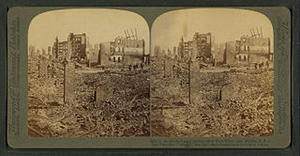EarthquakesThe likelihood of a California Big One “uncomfortably high”: Experts
Research on the San Andreas fault has shown that the average time between surface-rupturing earthquakes is about a century. Experts say that these findings are a call to action. The last two “big ones” on the San Andreas fault — in 1906 in Northern California and 1857 in Southern California — occurred more than a century ago. There are several ways to calculate the probability of a similar earthquake, but they all give uncomfortably high results. A large earthquake is likely in our lifetime. A magnitude 7.8 earthquake is realistic, one expert says. “Our data show that similar earthquakes happened here in the not-too-distant past. As Shakespeare said, past is prologue. However, past large earthquakes on the San Andreas fault affected very few people. Now millions are at risk.”

Stereopticon image of 1906 San Francisco earthquake // Source: commons.wikimedia.org
Lisa Grant Ludwig, professor and graduate director of public health at UC Irvine, local earthquake researcher, and president of the Seismological Society of America, helped develop the original Great Southern California ShakeOut in 2008.
Now an annual global event, it will next take place Thursday, 16 October, when at 10:16 a.m. millions of people in homes, schools, businesses, government offices, and public places will participate in the largest earthquake preparedness drill in the United States. Within hours, millions more around the world will participate in regional ShakeOuts.
In Southern California, the drill is based on a magnitude 7.8 earthquake along the San Andreas fault — a temblor about 500 times stronger than the 6.0 one that struck South Napa on 24 August.
In a conversation with the UCI news office, Ludwig discussed the chances of a large earthquake locally and what we can do to prepare.
Q: For years, we’ve been warned about “the big one.” As a researcher, have you come across clues indicating when or if it will happen?
A: Research on the San Andreas fault conducted by myself and others has shown that the average time between surface-rupturing earthquakes is about a century. These findings are a call to action. The last two “big ones” on the San Andreas fault — in 1906 in Northern California and 1857 in Southern California — occurred more than a century ago.
There are several ways to calculate the probability of a similar earthquake, but they all give uncomfortably high results. A large earthquake is likely in our lifetime.
Q: The centerpiece of the Southern California ShakeOut is a doomsday 7.8 earthquake on the San Andreas fault. Why did you develop a scenario featuring such a devastating temblor?
A: Because it’s realistic. Our data show that similar earthquakes happened here in the not-too-distant past. As Shakespeare said, past is prologue. However, past large earthquakes on the San Andreas fault affected very few people. Now millions are at risk.
Many people prefer to ignore this problem, in part because seismologists can’t say exactly when it will happen. But ignorance is not bliss. The ShakeOut scenario earthquake is 8,000 times stronger than the March 28 magnitude 5.1 La Habra earthquake, which ruptured water mains and was widely felt in Orange County.
Earthquakes cannot be prevented. The severity of impact depends on what we do — or don’t do — between now and the next earthquake. Everyone should “Dare to Prepare”! Last year, nearly 25 million people across the globe participated in a ShakeOut drill, and a larger turnout is expected this year. You can be part of the solution.
Q: What have you learned about the network of faults in Southern California?
A: “Network” is a good term to describe the system because there are many active faults that generate earthquakes. The San Andreas has the highest probability of generating a “big one,” but the network of smaller faults adds significant risk.
For example, the West Napa fault received little attention until 3:20 a.m. on Sunday, 24 August, when it generated a magnitude 6.0 earthquake, causing $300 million in damage and destroying many wineries and historic buildings. Closer to home, the La Habra earthquake occurred on a fault that was so minor, it still hasn’t been named.
The Southern California landscape was shaped by a network of similar faults linked to the larger San Andreas. Any of these faults could cause an earthquake at any time.
Q: What are common misperceptions about earthquakes?
A: Earthquakes happen during “earthquake weather.” California will fall into the sea in the next “big one.” Since earthquakes can’t be prevented, there’s nothing you can do to protect yourself.
Q: What do you hope can be learned from the ShakeOut?
A: First, I hope people will learn to drop, cover and hold on so that they’ll be prepared when they feel the next earthquake and they’ll know how to respond when an earthquake early warning system is eventually implemented in California.
Second, I hope people will learn good earthquake preparedness habits. For example, the La Habra and Napa earthquakes showed again that water lines can break and people may have to rely on their own water for days to weeks. Everyone should store water.
Finally, I hope people will learn to “secure their space” so that they’ll be protected from falling objects. Very few buildings collapse in California earthquakes, but many people are injured by the contents.
Q: Everyone is aware of the need for earthquake preparedness. But how much preparedness is necessary?
A: This is a question everyone in California should ask themselves. Assume you will be taking an unscheduled camping trip with your family or co-workers or neighbors for several weeks. There will be no potable tap water or plumbing or electricity or Internet or telephone. The supermarket will be closed. What should you pack?
